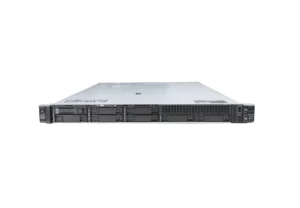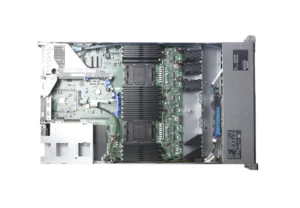What Makes the HPE DL360 Gen11 Stand Out in Containerized Workloads?
Key Features of the HPE DL360 Gen11 for Optimizing Performance
 The HPE DL360 Gen11 server is a sophisticated 1U two-socket rack server that takes the lead in delivering optimized performance for containerized workloads. Powered by Intel’s new generation Eagle Stream platform, it combines excellent computing capabilities, enhanced data transfer rates and massive memory depth. This renders it particularly suitable for virtualization applications requiring high computing density, flexibility and embedded security. Its capacity to support dual 4th-generation Sapphire Rapids or 5th-generation Emerald Rapids Intel Xeon Scalable processors of 64 cores per processor optimizes processing power to run high-end applications like EDA, CAD and VDI.
The HPE DL360 Gen11 server is a sophisticated 1U two-socket rack server that takes the lead in delivering optimized performance for containerized workloads. Powered by Intel’s new generation Eagle Stream platform, it combines excellent computing capabilities, enhanced data transfer rates and massive memory depth. This renders it particularly suitable for virtualization applications requiring high computing density, flexibility and embedded security. Its capacity to support dual 4th-generation Sapphire Rapids or 5th-generation Emerald Rapids Intel Xeon Scalable processors of 64 cores per processor optimizes processing power to run high-end applications like EDA, CAD and VDI.
HPE DL360 Gen11 is improved in memory configuration—it can accommodate a maximum of 32 DDR5 memory modules with a speed of up to 5600MT/s and can accommodate a maximum data capacity of 8TB in total. Organizations can utilize this feature to support scale containerized workloads with best performance. Apart from this, it also provides storage capacity by being able to support different configurations such as SAS/SATA/NVMe hard drives as well as being able to support up to 20 EDSFF NVMe drives—providing flexibility and scalability to customers.
How Does the HPE DL360 Gen11 Address Modern Computing Demands?
Businesses are embracing environments and containerized applications more and more these days. As a result of this trend, modern server technology has to keep up with these changing needs too. The HPE DL360 Gen11 makes things easier by offering a user cloud management interface, its self-service dashboard gives users a comprehensive view and valuable insights globally that help businesses move from reacting to situations to anticipating and planning. This automated approach boosts deployment effectiveness. Enables quick scalability when needed.
Security is a consideration with the HPE DL360 Gen11 as it utilizes trusted silicon root technology to oversee secure boot procedures and memory encryption along with secure virtualization features in an effective manner. The detection of firmware prevents the proliferation of harmful code and guarantees seamless server performance in the face of potential security risks.
How Does the HPE DL360 Gen11 Enhance Efficiency in Workload Management?
Benefits of Using the HPE DL360 Gen11 for Resource Optimization
Managing containerized workloads efficiently is crucial across environments to make the most of available resources effectively and maintain performance levels without any compromise on server performance monitoring and adjustment based on workload needs.
It can accommodate two M2 solid state drives for swapping as operating system boot devices, which helps in minimizing downtimes during maintenance and upgrades effectively improving efficiency levels. Its ability to work with RAID setups also ensures data integrity and optimizes storage performance well.
Streamlining Operations with the HPE DL360 Gen11’s Capabilities
The efficient layout of the HPE DL360 Gen11 eases tasks across all aspects of operation, offering a self-service interface and sophisticated management features, such as iLO Standard Edition granting full authority over IT infrastructure.
By integrating mobile app software into the system setup allows administrators to oversee and control operations from a distance in locations smoothly. Additionally, smart cooling components help maintain the temperature levels for improved energy efficiency and prolonged system life.
Why Scalability Matters and How the HPE DL360 Gen11 Delivers
 Having scalability is really important for businesses that want to make sure their IT investments can handle increasing workloads in the future. The HPE DL360 Gen11s design allows for growth and adaptation as needs change over time. It offers multiple PCIe slots and OCP network card options to help increase connectivity without the need for infrastructure modifications.
Having scalability is really important for businesses that want to make sure their IT investments can handle increasing workloads in the future. The HPE DL360 Gen11s design allows for growth and adaptation as needs change over time. It offers multiple PCIe slots and OCP network card options to help increase connectivity without the need for infrastructure modifications.
The fact that it can support a maximum of 10 SAS/SATA/NVMe drives or 20 EDSFF NVMe drives showcases its flexibility for storage heavy tasks often linked with containerized setups, making it easy for businesses to expand their operations smoothly while maintaining high performance and dependability.
The HPE DL360 Gen11 achieves a standard in optimizing workloads for containerized applications by utilizing cutting edge components, like speedy DDRS memory modules and robust Intel Xeon processors alongside customizable storage choices.
How Does Huaying Hengtong Support Customers with the HPE DL360 Gen11?
Comprehensive Services Offered by Huaying Hengtong for Deployment and Maintenance
Installation and Configuration Support from Huaying Hengtong
Huaying Hengtong offers assistance to help customers easily set up and configure the HPE DL360 Gen11 server in their IT setups efficiently. This server is a 1U two way rack server built upon Intel’s latest Eagle Stream platform and is dedicated to managing high density workloads. To fully optimize its capabilities, Huaying Hengtong provides instructions throughout the installation process to ensure all parts are properly configured.
Ongoing Technical Assistance Provided by Huaying Hengtong
After the server is up, Huaying Hengtong premises provide ongoing technical support to maintain optimal performance without any disruptions in service delivery. The technical experts are knowledgeable in handling issues encountered during daily tasks, such as adjusting BIOS configurations based on instant feedback from the server to help companies adjust to varying workloads efficiently. In the event of any security issues arising, the team of experts is there to guide you on using the server’s automated recovery functions to restore regular operations.
Ensuring Seamless Integration with Existing Systems Through Huaying Hengtong
Incorporating hardware into an established IT setup may pose difficulties. However, Huaying Hengtong makes this task easier for its clients by ensuring a smooth integration of the HPE DL360 Gen11 in hybrid environments through customized solutions that match the current systems seamlessly.
Their team assists companies in making the most of the servers enhanced connectivity features to seamlessly integrate with existing network setups. They also offer advice on how to use the servers self service console function for a view and understanding of system resource utilization. This assists businesses in shifting from being reactive to adopting management approaches.
Frequently Asked Questions about HPE DL360 Gen11
Q: What is HPE ProLiant DL360 Gen11?
A: The HPE ProLiant DL360 Gen11 is a 1U 2P rack-optimized solution that offers excellent compute performance, enhanced high-speed data transfer rate, and memory depth at 2P compute capability.
Q: What is the difference between HP microserver Gen10 and Gen11?
A: Processing Power: Gen10 supports up to 28-core Intel processors, whereas Gen11 supports up to 64-core Intel and 128-core AMD processors. Memory: Gen10 supports up to 3.0 TB DDR4 (2933 MT/s), but Gen11 supports 8.0 TB DDR5 (5600 MT/s). Networking: Gen10 supports up to 25GbE, but Gen11 jumps to 100GbE for high-speed throughput.
Q: What is containerized workloads?
A: Containerization is a type of virtualization in which all the components of an application are bundled into a single container image and can be run in isolated user space on the same shared operating system. Containers are lightweight, portable, and highly conducive to automation.
Q: What is the difference between pod and workload?
A: Workloads are objects that set deployment rules for pods. Based on these rules, Kubernetes performs the deployment and updates the workload with the current state of the application. Workloads let you define the rules for application scheduling, scaling and upgrading.











